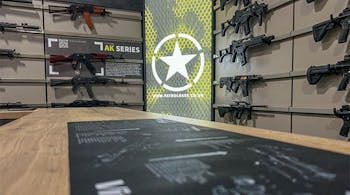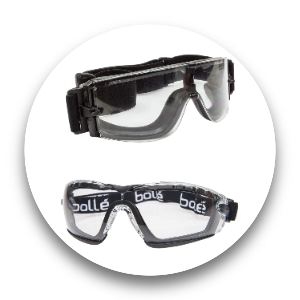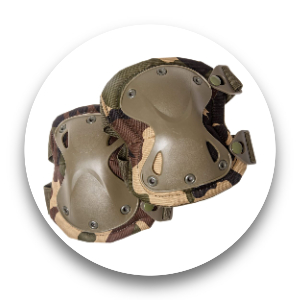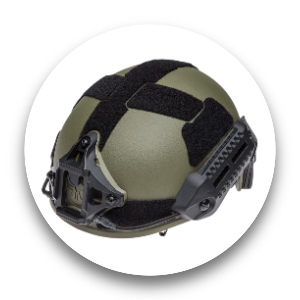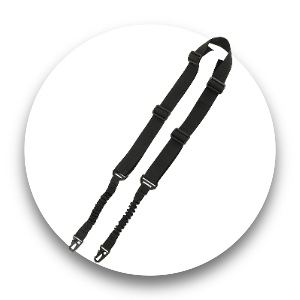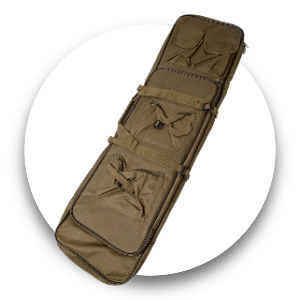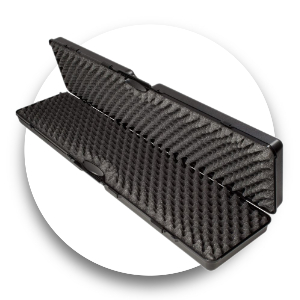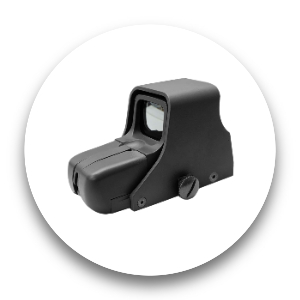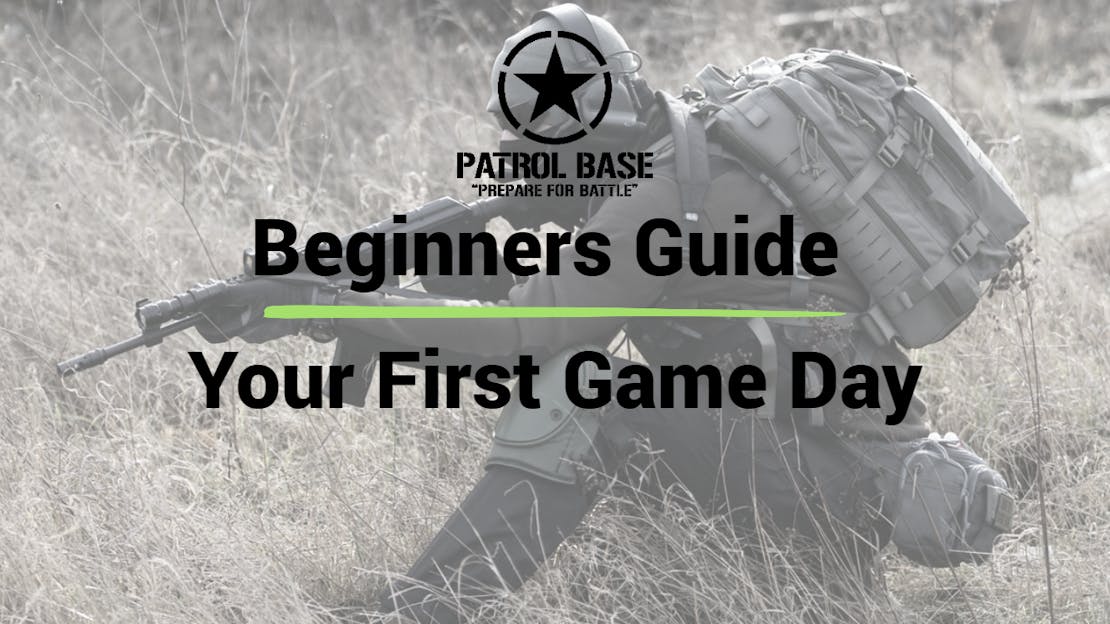
Beginners' guide: Your First Game Day
At Your First Skirmish
Before the game
Before the skirmish officially begins, you will be divided into teams and given a safety brief. Magazines will be kept off weapons (including pistols) and safeties engaged until you are in the game zone, where eye protection is mandatory. It is of the utmost importance that you listen closely to the safety brief, which will outline not only the safety-related rules of the game but the scenario, any advanced rules (medic rules, respawns, etc), and give you a rough idea of the layout of the site, which is more important than you might think. There is little worse than wandering around the woods looking for someone to shoot whilst utterly lost for half an hour because you were chin-wagging during the briefing! Believe me, I know! There are also those hard-nosed marshalls who will stop the brief and start from the beginning every time they catch someone talking, you don't want to upset these guys, the more time you spend re-listening to the briefing the less time you get to skirmish!
How does getting shot by a bb gun hurt?
If you have ever been pinched or flicked hard, you know what to expect when hit from a distance or over clothing. At extremely close range or on bare skin, taking an Airsoft BB feels like a Bee sting but with the pain lasting less than a second before it becomes dull. Airsoft guns can cause welts and marks on the skin, meaning it is important to wear protection if you are bothered about having small marks here and there. I'm sure many of you have been paintballing before, a single impact will hurt considerably less than a paintball marker. The flip side being Airsoft guns are considerably more accurate and have a higher rate of fire than a paintball marker, meaning you will generally get hit several times. Despite the Paintball markers using frangible ammunition (it breaks when it hits you), Airsoft is considerably safer, with the Airsoft legal limits of muzzle energy being approximately 1/14th of the average paintball marker. If you are afraid of getting hit it is important to accustom yourself to getting hit; being willing to take hits will give you an advantage on the field, allowing you to be aggressive and strike the opposing force in a manner they may not expect. Who dares, wins.
What clothing is suitable?
Footwear
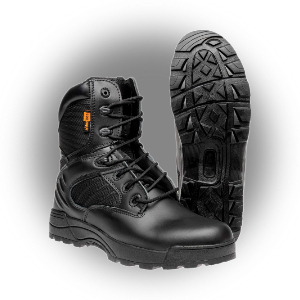 Airsoft is a highly dynamic sport, making use of varied terrain and often disused industrial buildings, which, whilst a defining element of the sport which makes the experience as realistic as possible, it also present risks for your feet if you aren't careful. My recommendation for footwear would be decent, comfortable boots with ankle support. This is obviously highly subjective and as long as your site accepts your footwear choice and you are content with any increased risk you are taking you can wear what you feel best in (high heels NOT recommended!). Many sites, particularly indoor sites will allow trainers but my personal preference is to use combat boots or mid-height hiking boots as they allow a good combination of mobility with solid protection for the toes and ankles. Military issue boots are great, particularly for woodland and outdoors as they will allow generally greater water resistance than hiking boots. Hiking boots have the advantage of being lightweight, allowing you to run a near trainer speed whilst availing yourself of reinforced toes, excellent arch support and ankle support, minimising the risk of injury. Many sites do insist on boots with ankle support and will not allow you to skirmish in trainers, as it can often be a part of the terms of their insurance if the site is deemed particularly risky with regards to foot injuries. Tennis this is not, you will be jumping and crawling and climbing over rubble and running through marshes, bare this in mind when selecting your footwear.
Airsoft is a highly dynamic sport, making use of varied terrain and often disused industrial buildings, which, whilst a defining element of the sport which makes the experience as realistic as possible, it also present risks for your feet if you aren't careful. My recommendation for footwear would be decent, comfortable boots with ankle support. This is obviously highly subjective and as long as your site accepts your footwear choice and you are content with any increased risk you are taking you can wear what you feel best in (high heels NOT recommended!). Many sites, particularly indoor sites will allow trainers but my personal preference is to use combat boots or mid-height hiking boots as they allow a good combination of mobility with solid protection for the toes and ankles. Military issue boots are great, particularly for woodland and outdoors as they will allow generally greater water resistance than hiking boots. Hiking boots have the advantage of being lightweight, allowing you to run a near trainer speed whilst availing yourself of reinforced toes, excellent arch support and ankle support, minimising the risk of injury. Many sites do insist on boots with ankle support and will not allow you to skirmish in trainers, as it can often be a part of the terms of their insurance if the site is deemed particularly risky with regards to foot injuries. Tennis this is not, you will be jumping and crawling and climbing over rubble and running through marshes, bare this in mind when selecting your footwear.
Protective Equipment
Obviously, you have to be a professional selective reader if you aren't aware that rated eye protection is mandatory on all Airsoft sites. Your choice of eye protection is down to your own preference, but I recommend starting with full seal goggles such as BOLLE Cobra or BOLLE X800i as they provide a greater level of protection and are less likely to fall off your head mid-battle (it has happened to me, not fun!). Mesh eye protection is also an option, bringing the advantage that they will never fog but there are some absolutely atrocious mesh goggles floating around on the likes of Amazon and aliexpress which would be absolutely unsafe for skirmishing, despite being marketed as Airsoft eye protection. Credible suppliers such as Heroshark and Nuprol are all I would trust for skirmishing, given the consequences of your eye-pro failing. Any mesh eyewear sold by Patrol base will be the type made from a sheet of steel with holes punched out, the only type that is skirmish safe. It is especially important that if you are going to purchase from amazon you do not purchase the 'wire mesh' style of goggles as in my experience they are outright dangerous. We recommend that you never go cheap on eye protection and always purchase from a credible Airsoft retailer or specialist PPE provider.
I always recommend that you wear face protection whilst skirmishing, primarily due to the pain of a face/nose shot and the risk to your teeth. Full face protection is usually optional for Airsoft skirmish attendees who are over 18 years of age, but at the ripe old age of 32 I practically always wear face protection, unless I am planning on staying far away from the action with a DMR or Bolt action snipers rifle. The perk of full-face protection is not just safety but it increases shooter confidence, making you more willing to stick your head out into the action, similarly to early combat helmets which resulted in a considerable increase in confidence of soldiers in combat, despite the borderline ineffectiveness of the steel and tin helmets of the time. Either a full face paintball style mask or mesh lower face mask combined with full seal goggles will provide optimum face protection, and provide you with the 'cajones' to put pressure on the opposing side whilst exchanging fire. It will also keep you looking pretty, in case you are out 'on the pull' after the game!
An additional piece of equipment that I overlooked when attending my first skirmish was knee pads. Uncomfortable and restrictive though they may be, you will beg for some the first time you kneel on a BB or thorn whilst in the heat of battle. Elbow pads are less important but if you do a lot of crawling, the same applies to kneeling on a BB as it does to put your elbow on one - ouch! Some combat trousers offer built-in knee pads such as those offered by Kombat UK, Viper and Emerson, but for those that don't, literally any knee pads are better than none. Knee pads for skateboarding or DIY will work fine and can be had last-minute for less than a fiver, but something like Vipers X-shell style are great and allow you to knee slide into cover - super cool! Knee pads offer a multitude of advantages to outweigh their downsides in my opinion, and will help you keep your knees and joints in good condition well into your elder years! Take a kneeling position with confidence, get yourself some knee pads!
If you are tall or clumsy, or even if not, a helmet can prove a wise investment. Many have advised me just to avoid bumping my head or running into trees, I would rather not have more than necessary to think about whilst skirmishing, so choose to wear a nice protective brain bucket! I wouldn't recommend starting with a real Kevlar helmet such as a surplus MK.6 as they are quite heavy and uncomfortable in comparison to more modern bump/ FAST style helmets and skateboarding helmets, and are more suited to the serious Milsim player. Helmets such as the FMA Special forces combat helmet or Emerson and 8 Fields FAST style helmets are great to start with if you have decided a helmet will suit your style of play/ level of clumsiness. Replica combat helmets are primarily about the look and won't provide the same amount of protection a bump/ FAST helmet will, but having some pads and thick plastic between you and that beam above your head would be sufficient for Airsoft purposes, plus they look sick! Another option is so-called Bump Caps, worn by the police and builders in certain scenarios. These are basically baseball caps with a thin plastic shell inside. They are nowhere near as tough as a helmet, but would still take the sting out of headshots and minor bumps. It is worth noting, helmets are not an essential piece of kit and you won't be turned away from any site for not having one, their primary purpose is to look cool and provide basic protection from the minor bumps and scrapes. If you are prone to overheating or are skirmishing in hot weather it would be worth considering carefully whether purchasing a helmet is right for you.
Clothing
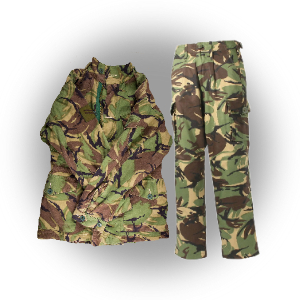
Clothing is something that will vary wildly between individual Airsoft skirmishers. You will see skirmishers in full gear, looking like they just fast-roped from a Blackhawk hovering over the car park, speed-softers who appear to have ridden their road bike to the skirmish and are still in their shorts and spandex, and casual skirmishers wearing a hoodie and trackies. It all comes down to how far you want to take your Airsoft experience, and in which direction. Wearing full Crye Precision combats with real plates in you carrier will not give you any real upper hand, nor will wearing skin-tight bright coloured clothing, ultimately it depends what your personal requirements are and what makes you feel comfortable.
If you are attending your first skirmish and have no Airsoft-specific clothing, you should think about the weather (always be mindful of temperature - stay hydrated and play safe!), which areas of your body you would like to protect, and what you will need to carry. Whenever I bring someone new to a skirmish who doesn't yet want to invest in combat clothing I recommend a hoodie and trackies/cargo trousers. This is because the hoodie will provide protection for your neck and ears and a kangaroo pocket for any game-related equipment you need to carry and the trackies/ cargo trousers will provide comfortable high-mobility trousers which will dry quickly if they get wet. I tend to avoid recommending jeans as, whilst they are hard-wearing, they tend to take forever to dry when wet and are heavy and prone to ripping when you run (especially modern, tight jeans). I definitely would never recommend wearing anything for a skirmish that you are unwilling to damage or get dirty. I would not personally recommend a balaclava. Many new skirmishers bring one, but it doesn't stay on for long because it tends to get unbearably hot. Unless it is part of a specific loadout, I would leave the 'bali' at home. Gloves are a must - you will learn this the first time you get shot in the fingers! No need to go over the top, a pair of cheap 'magic' gloves will do fine at taking the sting out of those knuckle and finger hits.
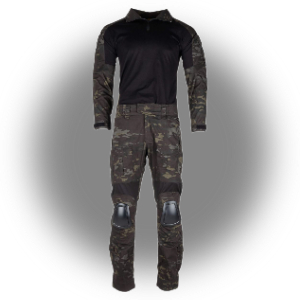 For those who are happy to invest a few quid, I would recommend starting with an Army issue field shirt and combat trousers. Not only are these basically designed for the job but they are cheap, lightweight, easy to move in, and dry very quickly, not to mention the plethora of pockets present. Soldier 95 DPM/DDPM stuff is great and the more recent MTP issue clothing is even better. Replica combat clothing is great as well, but pay particular attention to the sizing as many of these replicas are made in Asia and are in line with Asian sizing, running much smaller than European sizing. I would avoid getting a UBACs type combat shirt unless you have a plate carrier or body armour of some sort, as the UBACS gives up its pockets (which you will need if you have no rig) and is very thin around the torso, meaning getting hit through this will sting!
For those who are happy to invest a few quid, I would recommend starting with an Army issue field shirt and combat trousers. Not only are these basically designed for the job but they are cheap, lightweight, easy to move in, and dry very quickly, not to mention the plethora of pockets present. Soldier 95 DPM/DDPM stuff is great and the more recent MTP issue clothing is even better. Replica combat clothing is great as well, but pay particular attention to the sizing as many of these replicas are made in Asia and are in line with Asian sizing, running much smaller than European sizing. I would avoid getting a UBACs type combat shirt unless you have a plate carrier or body armour of some sort, as the UBACS gives up its pockets (which you will need if you have no rig) and is very thin around the torso, meaning getting hit through this will sting!
AEG Accessories
Setting aside the glamourous additions, such as tactical lights, optics, and VFGs (to be discussed in a future article) there is little you will need to run your AEG effectively at your first skirmish. The best thing you can do to increase your effectiveness with your primary is practice. Try to learn how your AEG shoots, adjust your HOP for the flattest trajectory possible, and practice engaging multiple targets and transitioning between targets quickly. Learn how to operate your selector switch and other functional parts of your AEG effectively and efficiently, software is just as essential as hardware in the game of Airsoft, as well as real combat. Don't be one of those "all the gear but no idea" guys. It can really enhance your game to have a decked-out AEG but without practice, all you are doing is complicating your AEG and slowing yourself down. Imagine adding 20 extra keys to your piano before even taking the first lesson, you are making things harder than they need to be.
Whilst there is an endless amount of cool stuff you can use to pimp out your rifle, one of the most useful and cost-effective additions for your AEG can be a sling, especially if you carry a sidearm or other secondary weapon. Slings are often overlooked by new Airsofters, but provide a way to carry your AEG whilst keeping your hands free when carrying out objective-based actions in-game and just giving your arms a rest when the combat dies down. Even if you run a lightweight setup, holding an AEG at a ready position for extended periods of time can leave your arms burning.
A rifle bag is a must for discrete and respectful transportation of your AEG. Many skirmish sites will ban people on the spot for carrying uncovered RIFs from their cars onto the site itself. You can make use of the box your AEG arrives in, to some extent (i.e it's better than nothing) however a rifle case or bag is much more secure and allows you to add a padlock, ensuring your AEG is not tampered with and doesn't inadvertently fall out in public! Hard cases such as the PARRA and NUPROL range are the best solution for this, however, a soft rifle bag such as Swiss arms and NUPROL PMC range of rifle bags are also great, and whilst they provide only a little protection from dropping they are much easier to carry on trains and public transport. You do not have to have a case or cover designed for the purpose, but something other than a bin bag is preferable. Treat your AEG with some respect, give it a nice home for when its not being used!
If you decide to go for an optic, ensure you think carefully before purchasing, and once you have it in hand, make sure you zero it properly. There is nothing more disappointing than thinking you are getting hits when your sights are off, especially when you are already in the heat of a firefight! A basic red dot sight is all you would want to start, with the option to move to more complex and fancy optics once you have grasped the basics. Worth noting is that the Iron sights provided on most AEGs will be fairly close to zeroed from the box, at least to a combat effective level, and as such are perfectly adequate for skirmishing. I personally choose to use Irons on some of my AEGs as there is no risk of getting an optic shot out if you don't have one, and I find irons work surprisingly well and are not vulnerable to bright sunlight, unlike optical sights which are hard to use when the sun gets low.
Skirmish Tactics tips
Don't be the type of skirmisher that thinks tactics are a mint used to freshen one's breath. The following three points are examples of mistakes new skirmishers make and how to avoid falling into the trap
- Keep your head on a swivel. It's easy to get tunnel vision when you are pumped with adrenaline and gagging for that kill, but be aware, more experienced players will use your single-mindedness against you. Make sure you are not only aware of your current target's location but also his teammates, be sure to have a good look around and either watch your own back or have a teammate cover the flanks and rear of the patrol whilst you take point up front.
- Communication is key. Make sure when you identify a target or take fire from somewhere you immediately inform your team of the direction and range of the target. Dead men tell no tales, if you get hit before you can tell your team where the incoming fire originates from you will have to watch in silence as they struggle, lest you draw the attention of a marshall and get a rightful telling off.
- Avoid the temptation to run back to where you last got shot. Unless it is key to achieving the objective, this is a surefire way to get yourself hit again. Most experienced Airsoft skirmishers know that there's a high likelihood that the guy they just sent back to respawn will return for revenge. They will be expecting it. Don't give them an easy time, if you are going back to the same location head there via a different route, and expect that the enemy has relocated in preparation for your return.
Well, there you have it! Our quick guide to what you will need for your first skirmish, what to expect and what you probably don't need at the early stages of your Airsoft career. Good luck at your first skirmish, remember the objective over all others is to have fun and enjoy the entire experience, even the painful parts!

